This article is intended to continue the Micscape series about unusual and small microscopes. This time we have a look at (and through) a school microscope, called "Kleinmikroskop B" produced in the eastern German town of Rathenow at the time when East and West Germany were two independent states. The last instruments of the type shown were produced in 19651. They have been replaced by a similar small portable low-cost microscope with draw-tube which is being produced in Rathenow up to the present day.
Rathenow has a long tradition in microscope manufacturing which began before 1800 and continues to the present day. Johann Heinrich August Duncker (*1767), the son of a priest, studied optics and lens grinding in Halle. Rathenow city claims that he started microscope production in about 1800 after his return from Halle to Rathenow.
Some of you will have seen "Busch Rathenow" microscopes at Internet auctions. After the Second World War the name "Busch" disappeared and merged into a "VEB" (i.e. a company owned by the citizens) which changed its name several times furtheron and supplied the East German Carl Zeiss Jena company for about 30 years.
The microscope we want to look at comes in a solid
wooden box (fig. 1). It has the company logo "ROW" (i.e. VEB Rathenower
Optische Werke) on top of it. The box is twice the weight
of the instrument (500 g versus 200 g). The microscope's low weight is
due to the extensive use of lightweight materials: Plastics for most parts
of the body, aluminium for the optics tube. The height of the microscope
itself is about 17 cm when ready to stow away and about 25 cm when the
zoom tube is extracted to full magnification. The signature on the front
reads "ROW Rathenow" (fig. 3). The instrument itself and the objective
have individual serial numbers, a fact which is quite unusual for a school
microscope.
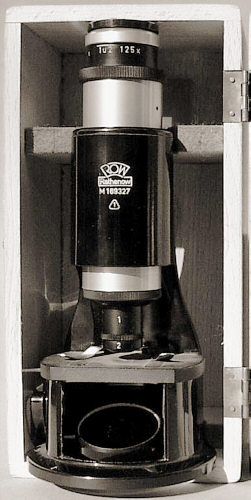
Figure 1 |
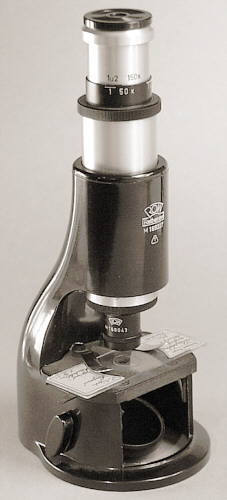
Figure 2 |
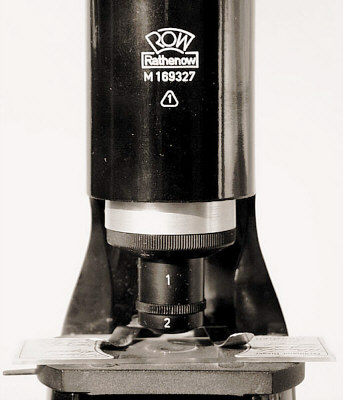
Figure 3
There are two levers on the right side of the body
(see fig. 4), a small one which allows the microscopist to choose between
three simple diaphragm choices (two holes of different size or nothing
at all) and a bigger toggle just below which serves to rotate the concave
glass mirror around the horizontal axis only. The microscope has no condenser.
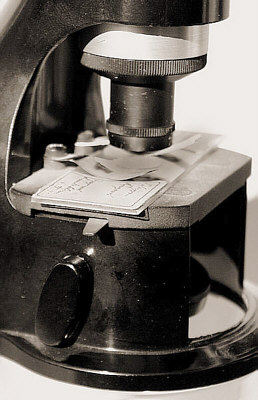
Figure 4
The magnification range is continuous, from 50x to
200x. This is achieved by a draw tube (which by that time had started to
fall into oblivion everywhere) and the single two-element objective with
removable front-lens. There are magnification readings on the tube which
show the different magnifications depending on tube extension with and
without front-lens. Keeping in mind the special requirements of a school
microscope, the front-lens glass is somewhat recessed by a safe distance
behind a solid metal mount (fig. 5).
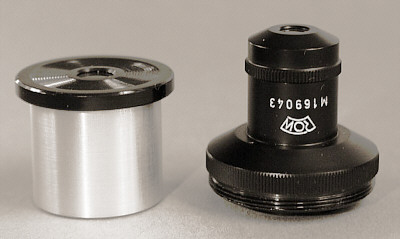
Figure 5
The single achromatic objective (ca. 13x) looks similar
to good standard microscope optics though it has no RMS thread. It performs
quite well. The eyepiece (about 15x) has glass lenses in a housing of plastics
and aluminium. The aluminium optics tube has a thread on the outer side
which doesn't move in a counter thread but instead in a piece of felt!
This is obviously due to cost or material constraints and makes fine focusing
difficult. Furthermore small felt fibre particles from time to time tend
to fall down on the slide under investigation. Nevertheless the overall
optical performance is quite ok and far above the level of modern toy microscopes.
The image below (fig. 6) has been taken through the objective of the ROW
Kleinmikroskop B at full magnification. The large diatom on the left measures
200 µm.
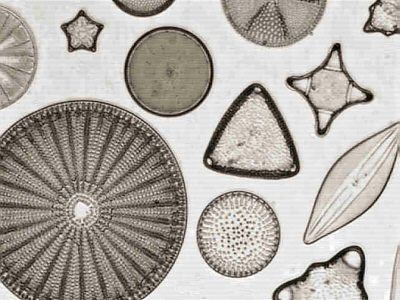
Figure 6
This photomicrograph can be compared with the images taken through other microscopes (cf. articles about the Tami Microscope here in Micscape and "30 g of microscope, please"). You will notice that the ROW school microscope performs not quite as well as the Tami microscope, which is no surprise when keeping in mind that the Tami was intended for professional use and had a professional price (a half month's workman salary). Those who are able to read in German language might like to look at the original instructions for the pupils which explain the basic functions. As there are only a few knobs to turn and to play with, the pupils will be able to concentrate on the microscopic subject and not become addicts to beautiful brass substage fine mechanics.
Though the manual has only two sides there was still some empty space for a discussion of the importance of cleanliness. Remember we are at school, teachers are fighting against chaos. Countless glass splinters within the microscope box witness past microscopic tragedies of hopefully grown-up users.
Comments to the author Martin
Mach are welcomed.
Footnote1 Many thanks to Mikroskop Technik Rathenow GmbH for this information.